Xingbo Dong
Explicit and Implicit Representations in AI-based 3D Reconstruction for Radiology: A systematic literature review
Apr 15, 2025Abstract:The demand for high-quality medical imaging in clinical practice and assisted diagnosis has made 3D reconstruction in radiological imaging a key research focus. Artificial intelligence (AI) has emerged as a promising approach to enhancing reconstruction accuracy while reducing acquisition and processing time, thereby minimizing patient radiation exposure and discomfort and ultimately benefiting clinical diagnosis. This review explores state-of-the-art AI-based 3D reconstruction algorithms in radiological imaging, categorizing them into explicit and implicit approaches based on their underlying principles. Explicit methods include point-based, volume-based, and Gaussian representations, while implicit methods encompass implicit prior embedding and neural radiance fields. Additionally, we examine commonly used evaluation metrics and benchmark datasets. Finally, we discuss the current state of development, key challenges, and future research directions in this evolving field. Our project available on: https://github.com/Bean-Young/AI4Med.
Test-Time Domain Generalization via Universe Learning: A Multi-Graph Matching Approach for Medical Image Segmentation
Mar 17, 2025Abstract:Despite domain generalization (DG) has significantly addressed the performance degradation of pre-trained models caused by domain shifts, it often falls short in real-world deployment. Test-time adaptation (TTA), which adjusts a learned model using unlabeled test data, presents a promising solution. However, most existing TTA methods struggle to deliver strong performance in medical image segmentation, primarily because they overlook the crucial prior knowledge inherent to medical images. To address this challenge, we incorporate morphological information and propose a framework based on multi-graph matching. Specifically, we introduce learnable universe embeddings that integrate morphological priors during multi-source training, along with novel unsupervised test-time paradigms for domain adaptation. This approach guarantees cycle-consistency in multi-matching while enabling the model to more effectively capture the invariant priors of unseen data, significantly mitigating the effects of domain shifts. Extensive experiments demonstrate that our method outperforms other state-of-the-art approaches on two medical image segmentation benchmarks for both multi-source and single-source domain generalization tasks. The source code is available at https://github.com/Yore0/TTDG-MGM.
Video RWKV:Video Action Recognition Based RWKV
Nov 08, 2024


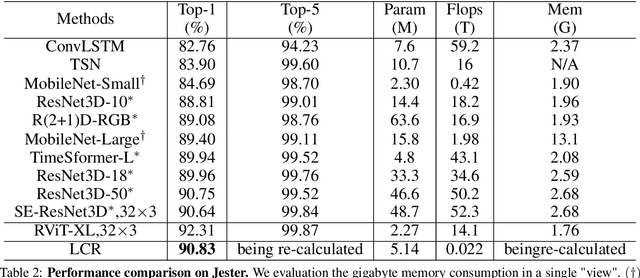
Abstract:To address the challenges of high computational costs and long-distance dependencies in exist ing video understanding methods, such as CNNs and Transformers, this work introduces RWKV to the video domain in a novel way. We propose a LSTM CrossRWKV (LCR) framework, designed for spatiotemporal representation learning to tackle the video understanding task. Specifically, the proposed linear complexity LCR incorporates a novel Cross RWKV gate to facilitate interaction be tween current frame edge information and past features, enhancing the focus on the subject through edge features and globally aggregating inter-frame features over time. LCR stores long-term mem ory for video processing through an enhanced LSTM recurrent execution mechanism. By leveraging the Cross RWKV gate and recurrent execution, LCR effectively captures both spatial and temporal features. Additionally, the edge information serves as a forgetting gate for LSTM, guiding long-term memory management.Tube masking strategy reduces redundant information in food and reduces overfitting.These advantages enable LSTM CrossRWKV to set a new benchmark in video under standing, offering a scalable and efficient solution for comprehensive video analysis. All code and models are publicly available.
Face Reconstruction Transfer Attack as Out-of-Distribution Generalization
Jul 02, 2024
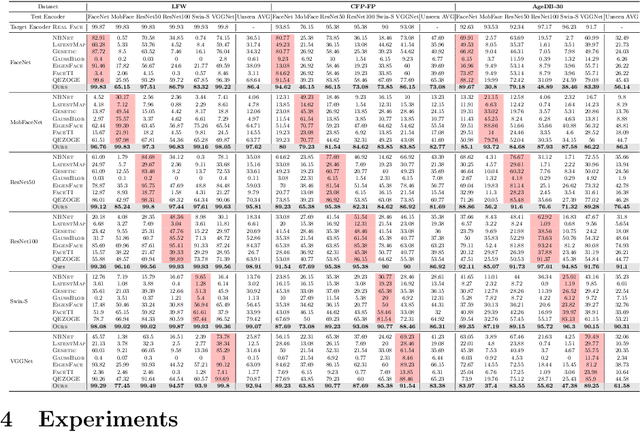

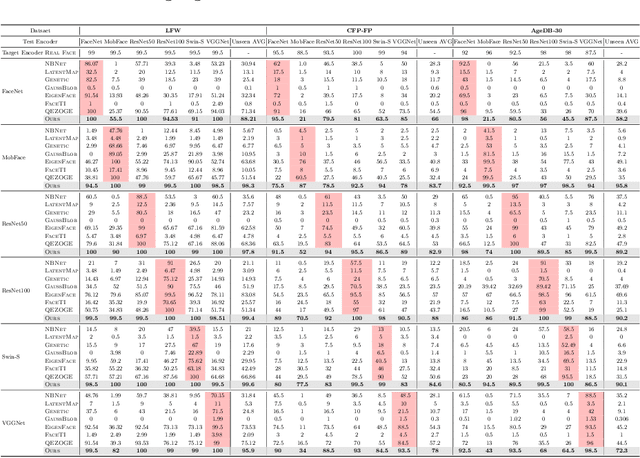
Abstract:Understanding the vulnerability of face recognition systems to malicious attacks is of critical importance. Previous works have focused on reconstructing face images that can penetrate a targeted verification system. Even in the white-box scenario, however, naively reconstructed images misrepresent the identity information, hence the attacks are easily neutralized once the face system is updated or changed. In this paper, we aim to reconstruct face images which are capable of transferring face attacks on unseen encoders. We term this problem as Face Reconstruction Transfer Attack (FRTA) and show that it can be formulated as an out-of-distribution (OOD) generalization problem. Inspired by its OOD nature, we propose to solve FRTA by Averaged Latent Search and Unsupervised Validation with pseudo target (ALSUV). To strengthen the reconstruction attack on OOD unseen encoders, ALSUV reconstructs the face by searching the latent of amortized generator StyleGAN2 through multiple latent optimization, latent optimization trajectory averaging, and unsupervised validation with a pseudo target. We demonstrate the efficacy and generalization of our method on widely used face datasets, accompanying it with extensive ablation studies and visually, qualitatively, and quantitatively analyses. The source code will be released.
IFViT: Interpretable Fixed-Length Representation for Fingerprint Matching via Vision Transformer
Apr 12, 2024Abstract:Determining dense feature points on fingerprints used in constructing deep fixed-length representations for accurate matching, particularly at the pixel level, is of significant interest. To explore the interpretability of fingerprint matching, we propose a multi-stage interpretable fingerprint matching network, namely Interpretable Fixed-length Representation for Fingerprint Matching via Vision Transformer (IFViT), which consists of two primary modules. The first module, an interpretable dense registration module, establishes a Vision Transformer (ViT)-based Siamese Network to capture long-range dependencies and the global context in fingerprint pairs. It provides interpretable dense pixel-wise correspondences of feature points for fingerprint alignment and enhances the interpretability in the subsequent matching stage. The second module takes into account both local and global representations of the aligned fingerprint pair to achieve an interpretable fixed-length representation extraction and matching. It employs the ViTs trained in the first module with the additional fully connected layer and retrains them to simultaneously produce the discriminative fixed-length representation and interpretable dense pixel-wise correspondences of feature points. Extensive experimental results on diverse publicly available fingerprint databases demonstrate that the proposed framework not only exhibits superior performance on dense registration and matching but also significantly promotes the interpretability in deep fixed-length representations-based fingerprint matching.
On Computational Entanglement and Its Interpretation in Adversarial Machine Learning
Oct 04, 2023Abstract:Adversarial examples in machine learning has emerged as a focal point of research due to their remarkable ability to deceive models with seemingly inconspicuous input perturbations, potentially resulting in severe consequences. In this study, we embark on a comprehensive exploration of adversarial machine learning models, shedding light on their intrinsic complexity and interpretability. Our investigation reveals intriguing links between machine learning model complexity and Einstein's theory of special relativity, through the concept of entanglement. More specific, we define entanglement computationally and demonstrate that distant feature samples can exhibit strong correlations, akin to entanglement in quantum realm. This revelation challenges conventional perspectives in describing the phenomenon of adversarial transferability observed in contemporary machine learning models. By drawing parallels with the relativistic effects of time dilation and length contraction during computation, we gain deeper insights into adversarial machine learning, paving the way for more robust and interpretable models in this rapidly evolving field.
Reconstruct Face from Features Using GAN Generator as a Distribution Constraint
Jun 09, 2022
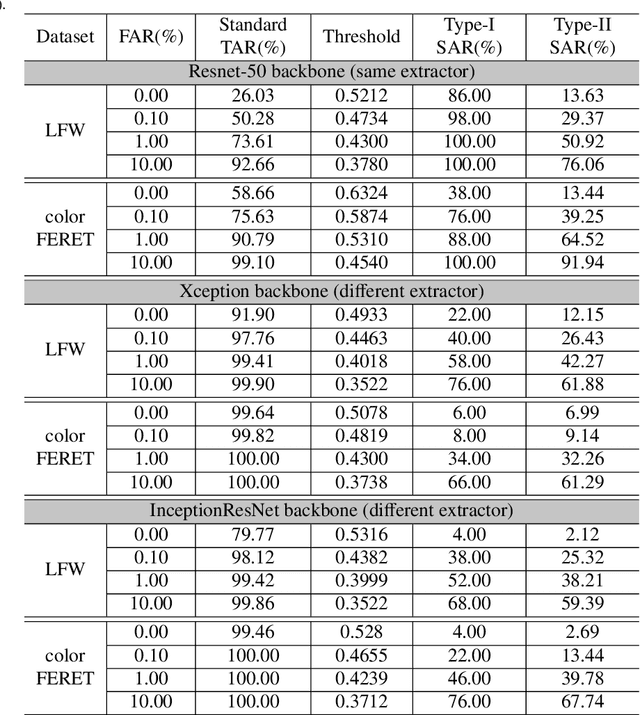
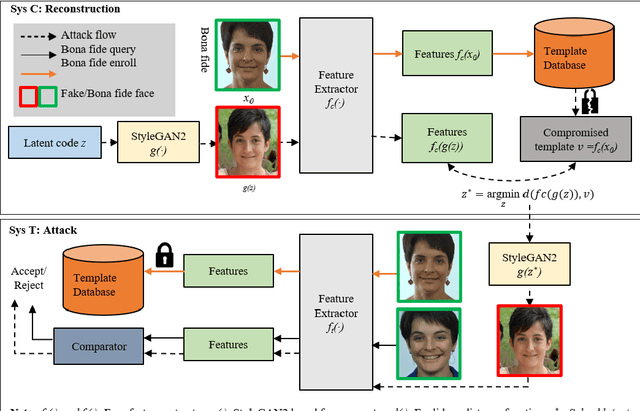
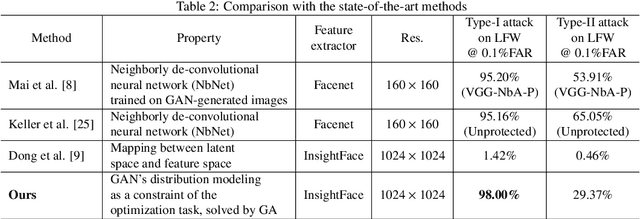
Abstract:Face recognition based on the deep convolutional neural networks (CNN) shows superior accuracy performance attributed to the high discriminative features extracted. Yet, the security and privacy of the extracted features from deep learning models (deep features) have been often overlooked. This paper proposes the reconstruction of face images from deep features without accessing the CNN network configurations as a constrained optimization problem. Such optimization minimizes the distance between the features extracted from the original face image and the reconstructed face image. Instead of directly solving the optimization problem in the image space, we innovatively reformulate the problem by looking for a latent vector of a GAN generator, then use it to generate the face image. The GAN generator serves as a dual role in this novel framework, i.e., face distribution constraint of the optimization goal and a face generator. On top of the novel optimization task, we also propose an attack pipeline to impersonate the target user based on the generated face image. Our results show that the generated face images can achieve a state-of-the-art successful attack rate of 98.0\% on LFW under type-I attack @ FAR of 0.1\%. Our work sheds light on the biometric deployment to meet the privacy-preserving and security policies.
Abandoning the Bayer-Filter to See in the Dark
Mar 22, 2022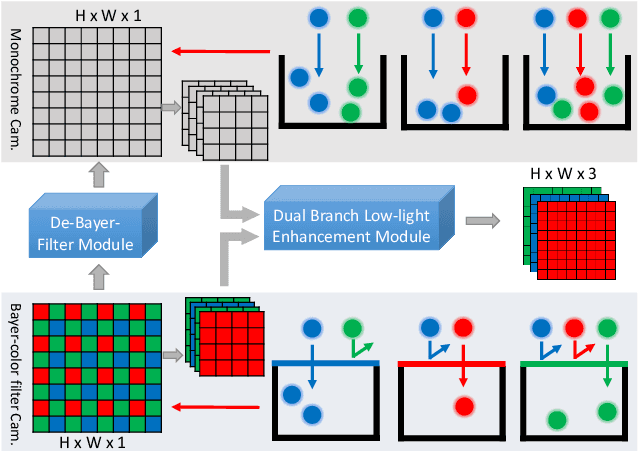


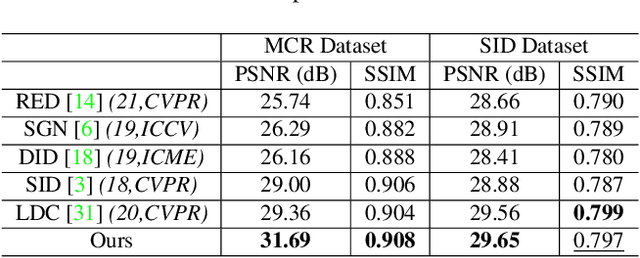
Abstract:Low-light image enhancement - a pervasive but challenging problem, plays a central role in enhancing the visibility of an image captured in a poor illumination environment. Due to the fact that not all photons can pass the Bayer-Filter on the sensor of the color camera, in this work, we first present a De-Bayer-Filter simulator based on deep neural networks to generate a monochrome raw image from the colored raw image. Next, a fully convolutional network is proposed to achieve the low-light image enhancement by fusing colored raw data with synthesized monochrome raw data. Channel-wise attention is also introduced to the fusion process to establish a complementary interaction between features from colored and monochrome raw images. To train the convolutional networks, we propose a dataset with monochrome and color raw pairs named Mono-Colored Raw paired dataset (MCR) collected by using a monochrome camera without Bayer-Filter and a color camera with Bayer-Filter. The proposed pipeline take advantages of the fusion of the virtual monochrome and the color raw images and our extensive experiments indicate that significant improvement can be achieved by leveraging raw sensor data and data-driven learning.
A Generalized Approach for Cancellable Template and Its Realization for Minutia Cylinder-Code
Mar 02, 2022


Abstract:Hashing technology gains much attention in protecting the biometric template lately. For instance, Index-of-Max (IoM), a recent reported hashing technique, is a ranking-based locality sensitive hashing technique, which illustrates the feasibility to protect the ordered and fixed-length biometric template. However, biometric templates are not always in the form of ordered and fixed-length, rather it may be an unordered and variable size point set e.g. fingerprint minutiae, which restricts the usage of the traditional hashing technology. In this paper, we proposed a generalized version of IoM hashing namely gIoM, and therefore the unordered and variable size biometric template can be used. We demonstrate a realization using a well-known variable size feature vector, fingerprint Minutia Cylinder-Code (MCC). The gIoM transforms MCC into index domain to form indexing-based feature representation. Consequently, the inversion of MCC from the transformed representation is computational infeasible, thus to achieve non-invertibility while the performance is preserved. Public fingerprint databases FVC2002 and FVC2004 are employed for experiment as benchmark to demonstrate a fair comparison with other methods. Moreover, the security and privacy analysis suggest that gIoM meets the criteria of template protection: non-invertibility, revocability, and non-linkability.
Multi-spectral Facial Landmark Detection
Jun 09, 2020



Abstract:Thermal face image analysis is favorable for certain circumstances. For example, illumination-sensitive applications, like nighttime surveillance; and privacy-preserving demanded access control. However, the inadequate study on thermal face image analysis calls for attention in responding to the industry requirements. Detecting facial landmark points are important for many face analysis tasks, such as face recognition, 3D face reconstruction, and face expression recognition. In this paper, we propose a robust neural network enabled facial landmark detection, namely Deep Multi-Spectral Learning (DMSL). Briefly, DMSL consists of two sub-models, i.e. face boundary detection, and landmark coordinates detection. Such an architecture demonstrates the capability of detecting the facial landmarks on both visible and thermal images. Particularly, the proposed DMSL model is robust in facial landmark detection where the face is partially occluded, or facing different directions. The experiment conducted on Eurecom's visible and thermal paired database shows the superior performance of DMSL over the state-of-the-art for thermal facial landmark detection. In addition to that, we have annotated a thermal face dataset with their respective facial landmark for the purpose of experimentation.
 Add to Chrome
Add to Chrome Add to Firefox
Add to Firefox Add to Edge
Add to Edge